 Cathedral/Tombstone
Models
Cathedral/Tombstone
Models
For all the glory of the consoles, they do
tend to eat up a lot of space. It's nice, therefore, to see the compact
designs of a lot of the table models. Even though there is still some dead
space in a lot of them, compressing the innards of a console into a space
1/3 the volume is still something of a feat. (Smaller sets are also a LOT
easier to force into the Honda.) On this page, I am going to focus
on the cathedral and tombstone radios. Among these sets are undoubtedly
my favourite radios, most notably the Rogers R646 that appears in the header
of each page.
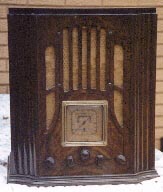
|
Make: CGE
Model: A82
Year: 1935
Tubes: 6F6, 6F5, 6H6, 6J7, 6K7 (2), 6L7,
5Z3
Power: 60-cycle
Schematic: Available
Acquired: Ottawa Antique Mkt,
1995
Made in: Canada (Toronto?) |
|
Of all my sets, this has one of the best
original finishes. I've just done a little touching up here and there.
This was something of a surprise, since the lacquer had gone green when
I bought it, and I figured the set was due for a good stripping. This is
another in the long list of wondrous reclamations made possible by generic-brand
hand cleaner. Now, this set is interesting because it is from the year
when metal tubes were introduced for radios, and this has almost the full
line-up of them. Aside from that, the centre knob can be pulled out to
adjust between fine and coarse tuning. (Like I've said, I amuse easily.)
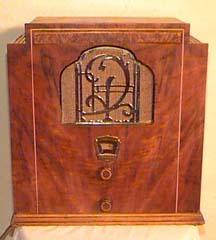
|
Make: Grunow 
Model: 500
Year: 1933
Tubes: 6F7, 78, 75, 47, 80
Power: 60-cycle
Schematic: Available
Acquired: eBay auction, 1999
Made in: USA |

|
This set was refinished before I got it, but
the quality of the job seems pretty good. It still needs to have
the detailing done, though, so this may be a good time to invest in the
spray lacquers with the toners and see just what I can acomplish.
I love the styling in this radio. While the chrome adds a little
flash to the overall design, it's really the Art Nouveau elements of
that grille that do it for me. Its freeform design really sits
well against the more rigid geometry of the rest of the set. I
couldn't say who was doing their design work, but I think this came out
of a pretty inspired moment. I now want to find one of the
800-series Zeniths with the chrome grillework.
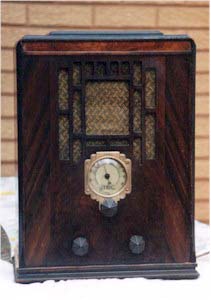
|
Make: Lyric
Model: ?
Year: c.1936
Tubes: 80, 41, 6C6, 6D6, 6A7
Power: 25/60-cycle
Schematic: Unavailable
Acquired: Ottawa Antique Mkt,
1995
Made in: ? |
|
The origins of this set are a complete mystery
to me. There is absolutely nothing on the chassis save what might
be a serial number, but I'm not even convinced of that. Last year,
I saw another Lyric for the first time, and the chassis in it was produced
by Grimes Radio in Kitchener, the same company who built chassis for Serenader.
So is Lyric a subset of Serenader? Or another Simpson's brand?
I have no idea. This set needed a few repairs once I got it home,
mainly because some of the tubes did not take well to the fact that it
was -36 outside and I had to take it home on the bus. Gotta love
Ottawa. The base had warped so bad that I had to use a router
to cut a new channel for the body to sit in. The left side also had
to be rebuilt. I haven't gotten to the refinishing yet.

|
Make: Philco 
Model: 20-A
Year: 1930
Tubes: 24 (3), 27, 71 (2), 80
Power: 25/40-cycle
Schematic: Available
Acquired: private sale, 1999
Made in: Toronto |
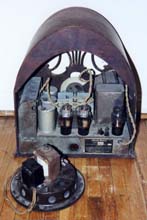
|
I got this set together with my Philco
90. The escutcheon, knobs and speaker mounting screws are all
missing, though I should have the knobs soon. The case has been
stripped, but is pretty solid. There are two small chips in the
grille area that will need attention, but are pretty easy fixes.
The chassis is phenomenal. It looks as though it has never been
messed with. The speaker also seems fine, so the mechanical
reapirs should not be too tough to deal with. The tube shield is
in place, and most of the tubes are Philcos, but none are of the old
balloon style. Normally, I would not pick up a set that was
missing parts the way this one is, but bundled with that 90, there was
too much to resist. I think it should come out fine, once the
remaining parts have been found. Fired it up using a rheostat to
increase the voltage bit by bit, and it sounds great. The old
oil-filled capacitor was still good!
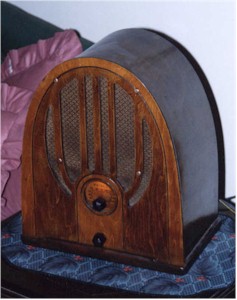
|
Make: Philco
Model: 84
Year: 1935
Tubes: 77 (2), 42, 80
Power: 25-cycle
Schematic: Available
Acquired: Ottawa Antique Mkt,
1995
Made in: Philadelphia, USA |
|
This is a really nice little cathedral that
unfortunately was refinished before I got it, so I can't really be sure
what the colours were supposed to be. It has great sound for a four-tube
set but has no AVC, so it really blasts you if you change from a weak station
to a strong one. (This can apparently be compensated for by adjusting
a capacitor in the back of the chassis, but the set works well enough for
my liking as it is.)
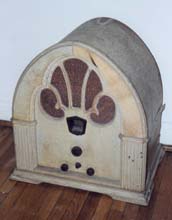
|
Make: Philco 
Model: 90
Year: 1931
Tubes: 24 (3), 27 (4), 47, 80
Power: 25/40-cycle
Schematic: Available
Acquired: private sale, 1999
Made in: Philadelphia, USA |

|
I finally found myself a Philco 90.
This is a US set that somehow made its way north. The case had a
lot of surface troubles - mainly peeling veneer, but with the exception
of some missing material around the grille area, it has all gone back
together and seems fine. I was pretty concerned about missing
veneer on the arch, but the pieces were there to rebuild it
completely. The case has been covered in some sort of white
finish. It come away with hand cleaner. Unfortunately, the
lacquer has been stripped away underneath, so a full refinishing is in
order. The tube shield is in place, as well as the big
capacitors. Mechanically, the set looks very clean, and once I
get a #24 tube for it, I am anticipating a pretty simple fix. I'm
really excited about this set. It should be a real showpiece when
complete. There's a little bit of distortion, but this set works,
which surprises me to no end.
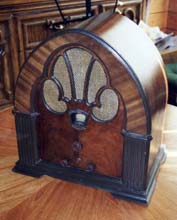
|
Make: Philco 
Model: 90-A
Year: 1931
Tubes: 24 (4), 27 (2), 45 (2), 80
Power: 25/40-cycle
Schematic: Available
Acquired: private sale, 1999
Made in: Toronto |

|
Hot on the heels of my Philco 90
acquisition, I got the 90-A. This is the Canadian version of the
same radio. There are some minor differences between the
two. The escutcheon is different (this one is brass, instead of
the brown plastic on the 90), as one example. This set must also
have been made slightly earlier, as there is a local/distance switch
(actually labelled 'normal/max.') instead of the AVC that my 90
has. According to my guides, this change was made in October,
1931. The tube shield is in place, and the rest of the chassis is
clean. Three old balloon tubes are there, and there does not seem
to be much standing between this radio and functionality. It has
been refinished, but there are little dings and knocks in it, so I am
considering doing at least a touch-up on it. As it turns out,
this set was missing the rectifier (80) tube, which was impossible to
see through the dust. Once replaced, and with one new output tube
(45), the set sounds phenomenal.
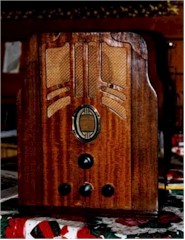
|
Make: Philco
Model: 3610A
Year: 1936
Tubes: 6A7, 78, 75, 42, 80
Power: 25/40-cycle
Schematic: Available
Acquired: Aberfoyle, 1995
Made in: Toronto |

|
I learned an awful lot about cabinet work from
this radio because it needed so much of it. If I were to see it now,
I wouldn't go near it, but at the time, I didn't have any Philcos and I
was feeling brave enough to try this one. An on/off switch had been
wired through the side, the shoulders had split apart, the patches needed
are obvious and the veneer had been sanded paper-thin, making them very
tough to do. I also learned never to try to mix stain and lacquer
together (serious mess). The radio, as it stands, is OK, but I think
I will end up stripping it yet again to try to clean up any lingering faults
(particularly near the patches). I also made the one error that should
never be made with one of these - I tried to clean the dial. For
whatever reason, the ink comes right off and I now have a streak on the
low end of the dial. I've since heard these referred to as "wash-away"
dials, and there are replacements for them, but as a word to the wise,
if you have a Philco from the late 30's, leave the dial alone.
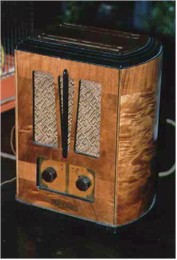
|
Make: RCA
Model: 4X
Year: 1934
Tubes: 6A7, 6F7, 43, 25Z5
Power: 60-cycle
Schematic: Unavailable
Acquired: Aberfoyle, 1993
Made in: USA (Camden, NJ) |
|
This little thing is one of the prettier
radios I've seen. Dan managed to buy it a few seconds before I would have.
One of these days, I'll forgive him for that. He was kind enough (I think)
to let me do the refinishing on it, although I still think I should have
run pinstripes up the sides where the joint is. I also built a pair of
feet for it. They're hard to see as they're painted black and are just
little stubby things. This has a side-mounted chassis and those are air
vents up top. It still has the original resistive power cord, which Dan
keeps threatening to replace. The dial has bad wear on it, and I haven't
seen any of those dial-manufacturing companies that produces this particular
one. Most do that other RCA with the divider down the centre.
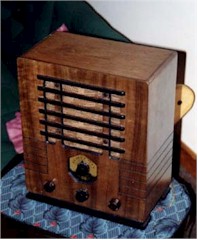
|
Make: RCA Victor
Model: 106
Year: c.1934
Tubes: 6A7, 41, 84, 6F7
Power: 25/60-cycle
Schematic: Unavailable
Acquired: Circle M,
Clappsion's Corners, 1996
Made in: Montreal |
|
I caught a bit of a break with this set.
I bought it from a guy who never gave me much of a deal on anything, and
who I felt tried to stick it to me on a couple of occasions. This
one time, I had fiddled with the knobs before asking him the price.
He quoted something like $100, saying that it was running. To show
me, he plugged it in and turned it on. Nothing. Wanting to
make the sale, he dropped it down to $60. Once it got it home, I
figured out that the local/distance setting was broken and I had accidentally
rotated it such that the contacts were exactly between the two settings.
Set back in the right place, it worked like a charm. The radio was
stripped and refinished when I got it. I've redone it, guessing at
what the colours might have been. Also had to glue that plastic dial
back together.
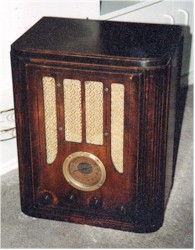
|
Make: RCA
Model: 118
Year: 1934
Tubes: 6A7, 6D6, 6B7, 41, 80
Power: 50/60-cycle
Schematic: Available
Acquired: Ottawa Antique Mkt,
1996
Made in: USA (Camden, NJ) |

|
The finish on this set came back this far with
the hand-cleaner treatment, but beyond that, I'm not going anywhere near
it. It has been shadowed, which is to say that the tone of the finish
changes as it approaches the corner. Without a sprayer, I see no
way to mimic this. I just read in a catalogue about a spray lacquer
that has the toner in it and might do the job, but I'll wait to get a little
braver first. The far right knob is the range selector, which pulls
in and out instead of turning right to left. The coarse/fine tuning
works much the same way.
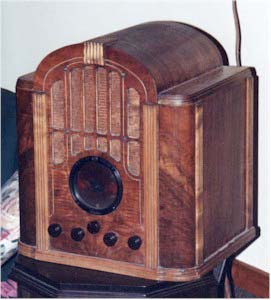
|
Make: RCA
Model: 143
Year: 1933
Tubes: 42 (2), 75, 76, 6A7, 6D6 (2), 5Z3,
Power: 60-cycle
Schematic: Available
Acquired: Ottawa Antique Mkt,
1997
Made in: Canada |
|
This radio has been refinished with some kind
of urethane that will have to come off. I'm also fairly sure that
the detailing should be much darker. At least, it will be once I'm
done with it. I had wanted a set like this for a long time, and was
really excited to find it on a visit back to Ottawa. That dial glows
bright red and is very neat with the lights out. This is currently
my sporting-event radio - the one that all the ball or hockey games are
played on. It does a very nice job of it. I think this radio
came either from Quebec or French Ontario, as one of the tube shields has
a service date marked on it in pencil -'23 mai, 1944'.

|
Make: Rogers
Model: R646 "710/715"
Year: 1934
Tubes: 551(3), 227(2), 245(2)
Power: 25-cycle
Schematic: Available
Acquired: Vintage Radio,
Toronto, 1993
Made in: Toronto |

|
This is a 25-cycle AM set produced by the company
that is now Rogers Cablesystems. They also produced the first AC-powered
set in Canada, if not the world. It was first seen at the CNE grounds in
1925 and had to be plugged into a light socket. (Check out this Rogers
page I found to see a picture of it.) I saw one of these in terrible
shape, and the guy still wanted $300 for it. Maybe if I were making more
money.... Anyway, the finish on this particular set had gone black with
age, so I had no idea that this amazing wood was underneath it. It also
needed a new push-pull transformer. The Rogers sets are generally my favourites
on account of the cabinet workmanship and wonderful dials. (They also,
unfortunately, need the oddest assortment of custom tubes that nobody has
ever heard of.) If, when all is said and done, I can only keep one of these
sets, it will be this one.

|
Make: Rogers
Model: 28 "Ten-50/55",
Year: 1936
Tubes: 6A7M, 80, 41M, 75M, 88M, 6A8
Power: 25/60-cycle
Schematic: Available
Acquired: Ottawa Antique Mkt,
1995
Made in: Toronto |
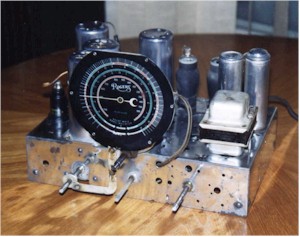
|
This set was refinished kind of poorly before
I got it, and I haven't gotten around to fixing it yet. What I have
done is the detailing around the dial and grille. This is another
of the green-dial Rogers sets that unfortunately tend to have dial damage
from oversized bulbs. This is actually a very nice three band radio
that is quite powerful - I used it in Ottawa to pick up Leaf games on skip
from Sarnia, several hundred miles away. It is also an example of
how Rogers liked to make things unnecessarily difficult. The chassis
number is completely unrelated to the model number, which cannot really
be determined. Like most Rogers' sets, the tubes are weird and hard
to come by.
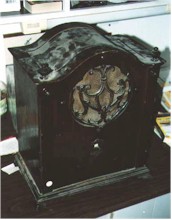
|
Make: Sparton
Model: 410 "Junior"
Year: 1931
Tubes: 224 (2), 183 (2), 227, 280
Power: 25-cycle
Schematic: Available
Acquired: Vintage Radio,
Toronto, 1996
Made in: London, Ont. |
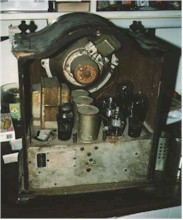
|
This is the radio that is covered in a little
more depth on the project page, but I thought it would be remiss of me
not to include it here among its friends. The weather is just getting
warm enough for me to start in on the refinishing job. I've rebuilt
that case as best I can, and the chassis sings like a bluebird. (NOT a
radio that I can afford, but I did get one of those fakes and quite like
it.) What a job this one has turned out to be. (Word to the wise:
if you see a repwood grille bending and cracking, RUN!!!) All signs,
though, point to it being worth it.

|
Make: Stewart-Warner
Model: 177
Year: 1934
Tubes: 6D6 (2), 6A7, 75, 41, 80
Power: 25/60-cycle
Schematic: Available
Acquired: Ottawa Antique Mkt,
1996
Made in: Belleville, ON |

|
I got a really nice surprise from this set when
I finally bit the bullet and stripped it. What I thought was a painted
finish on the top turned out actually to be a very nice bird's-eye maple,
and that stripe near the bottom which looked like a decal is actually inlaid
wood. Awesome! It's great to find that you got a higher-quality
object than you realized. I've now got it refinished with five coats
of the paste varnish and then a French polish. It could maybe have
been a little redder, but it's not bad, all in all. It's a
very handsome little set.
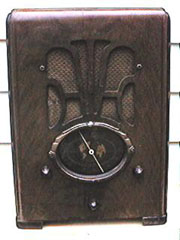
|
Make: Unknown 
Model:
Year: c.1935-36(?)
Tubes: 6D6, 6C6, 43, 25Z5, K55H
Power: 60-cycle
Schematic: Unavailable
Acquired: eBay auction, 1998,
Made in: |
|
I'm pretty baffled by this set. There
are no markings of any kind on either the cabinet or the chassis.
The dial bears some resemblance to some RCA dials with the world map on
them. Beyond that, though, there's pretty little to go on.
The chassis was pretty frightening, as all caps had been replaced with
brand new ones (normally good, but a lot of original wires were left
dangling) and the layout was really unfamiliar. It turns out that
a broken coil was holding this set back. The radio itself is just
a pair of tuned circuits, which is a little odd on a set made this
late. The cabinet has stripped well, but there is a cigarette
burn on the top that will take some effort to mask. I'm going to
shadow this set and hope to hide it that way.
Cathedral/Tombstone sets
still to come:
I've actually caught up here - have to buy
another, I guess....
Back
to Main Page

































